|
|
|
|
Index to our previous shows
January 25, 2004 - Gene Cernan
January 10, 2004 - Michael Cassutt
Shows from December, 2003
Shows from November, 2003
Shows from October, 2003
Shows from September, 2003
Shows from August, 2003
Shows from July, 2003
Shows from June, 2003
Shows from May, 2003
Shows from February, 2003
Shows from January, 2003
Shows from December, 2002
Shows from November, 2002
Shows from October, 2002
Shows from September, 2002
Shows from August, 2002
Shows from July, 2002
Shows from June, 2002
Shows from May, 2002
Shows from April, 2002
Shows from March, 2002
Shows from February, 2002
Shows from January, 2002
Shows from December 2001
Shows from November, 2001
Shows from October, 2001
Shows from September, 2001
Shows from August, 2001
Shows from July, 2001
Shows from June, 2001
Shows from May, 2001
Shows from April, 2001
Shows from March, 2001
Shows from February, 2001
Shows from January, 2001
Shows from November - December, 2000
Shows from September - October, 2000
Shows from July - August, 2000
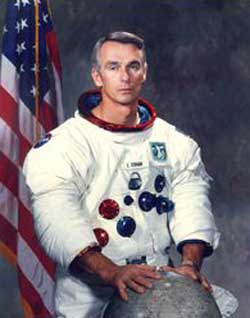
|
|
On Sunday - January 25th, 2004 - our guest was astronaut Gene Cernan.
In 1972 Gene Cernan commanded the Apollo 17 mission to the Moon and became, as he hates to say, "The Last Man on the Moon". No one expected that more than thirty years later he would still have that title. In 1999 he used that phrase as the title for his autobiography. We had the opportunity to interview him at that time while he was on tour promoting his book. Suzanne suggested that we re-air that interview from 1999 today, since it is even more timely now than it was back then.
|
The Last Man on the Moon is Gene Cernan's frank and honest autobiography. In it he tells not just the story of his life as an astronaut, but gives you insights into the choices he made in his life. He isn't afraid to tell about times when he screwed up and made mistakes, like we all do. But what impressed me most about his stories was that he never made excuses for himself and always took responsibility for his actions.
Like the time he was 'hot dogging' in a helicopter and crashed while the decision about who was going to command the Apollo 17 mission was still up in the air. In the post-crash debriefing Deke Slayton offered him an easy way out from this embarrassment. "So, exactly when did the engine quit on you?" asked Deke. "It didn't. I just screwed up", was Gene's answer. The two men went over this issue several times, but Gene never waivered. He knew what he did and knew he had to be responsible for his actions. In the end the honest story about what happened was the one that was reported and Gene Cernan went on to get command of the last mission to the Moon.
To many Gene Cernan is a hero because he was an astronaut who flew to the Moon. But in my mind he's a hero because he took responsibility for his actions and was honest about what he did and why he did it. His book, The Last Man on the Moon is most highly recommended and is not to be missed.
|
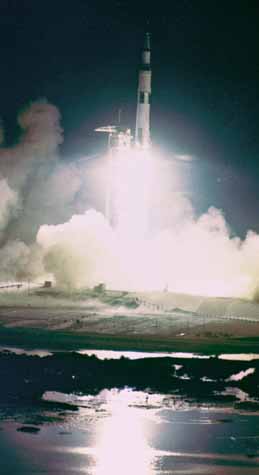
Image Credit: NASA
|
|

Cover Copyright © 1999 St. Martin's Press
|
On December 7, 1972 night was turned into day as the last of the Apollo missions to the Moon was launched into space.
|

Image Credit: NASA
|
Gene Cernan exuberantly leaps into the air and salutes the flag while on the last Lunar expedition of the Apollo program. This picture was taken over 30 years ago.
It is now time for the ground to shake again with the roar of humans traveling to other worlds. Gene Cernan might currently be 'the last man on the Moon', but that is a title he would gladly give up. And with the President's recent announcement of a plan to send humans back to the Moon and beyond, that might be happening soon.
|
Dateline: Mars
Opportunity
Last night the Mars Exploration Rover Opportunity successfully landed on Mars in the region known as Meridiani Planum. Within a few hours color images were coming back to Earth and the scientists were growing impatient for their robotic sibling to go off exploring.
|

Image Credit: NASA/JPL
|
Shown above is the first color image returned by the Opportunity Mars Exploration Rover. The sandy surface is quite unlike the rocky plains seen by other Mars landers. Those circular marks on the ground are thought to be the impressions left by the spacecraft's airbags when it bounced down on Mars.
|

Image Credit: NASA/JPL
|
Above you see one of the early black and white images returned by Opportunity. Those rocks off in the distance are thought to be an example of bedrock peeking out from beneath the sands of Mars.
|
Spirit
Meanwhile, on the other side of Mars, the Spirit rover continues its mission of exploration. There were some heart-stopping moments when the spacecraft was unable to communicate with the Earth for more than a day. But the engineers and scientists at JPL have been working the problem and they are back in communication with Spirit. They think they will be able to solve the problem and have Spirit back on-line and working in a matter of days or weeks. Till then, we have these images of Mars to whet your appetite.
|
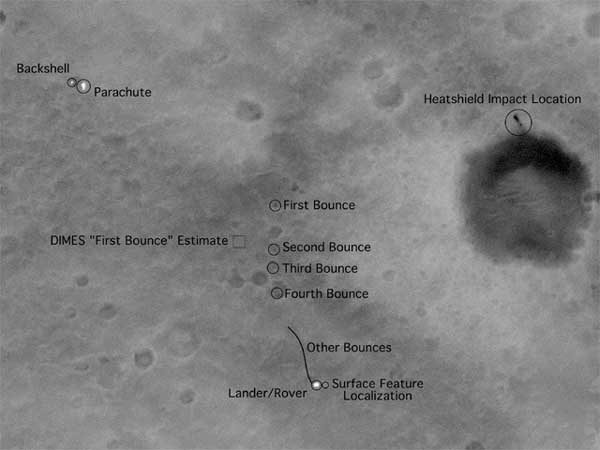
Image Credit: NASA/JPL
|
On January 19, 2004 the Mars Global Surveyor spacecraft snapped this picture from orbit showing the landing site for the Spirit rover. The detail of this image is so high that you can even see the lander/rover sitting on the Martian surface and the marks left on the ground when the spacecraft bounced down on Mars.
|
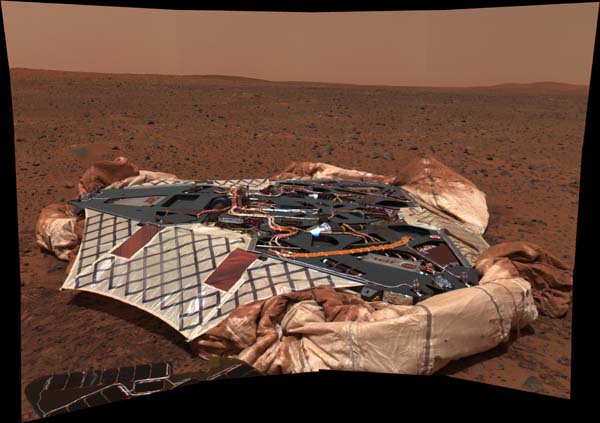
Image Credit: NASA/JPL
|
As the Spirit rover rolled off its landing stage it turned its camera back to take this photograph of the vehicle that had delivered it to the surface of Mars.
|

Image Credit: NASA/JPL
|
Show above is a 360 degree panorama of the Martian surface as seen by the Spirit rover. To view a wondrous QuicktimeVR version of this image that will take your breath away click here. Warning, that QuicktimeVR image is large and bandwidth intensive. But well worth it! It's like you are there, in person, on Mars looking around at a landscape that is just waiting to be explored. Let's go!
|
Listen to this show
|
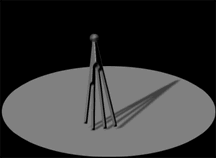
|
- Click here to listen to the entire show. {1:01:54}
Or
- Click here for the show's intro music.{0:41}
- Click here for the show's opening. {30:04}
- Click here for our interview with Gene Cernan. {29:04}
- Click here for the show's closing.{2:05}
- Click here for an index of all Shows on our site.
|
Click here if you have a problem hearing the show and you're using Internet Explorer.
If you enjoyed this show and would like to know when other interviews are uploaded to the Hour 25 web site, then send an email to me at wwjames@earthlink.net and I will add your name to the free Hour 25 Newsletter mailing list. That way you'll get a brief notice in your email every time a new show gets uploaded to the web.
Links for more information relating to this week's show
Gene Cernan and the Apollo Project
You can learn more about Gene Cernan at his Web Site.
One of the best compendiums of information about the Apollo missions to the Moon can be found at The Apollo Lunar Surface Journal and at the companion Flight Journal web sites for Apollo 8, Apollo 15 and Apollo 16.
Information about the scientific data returned by the Apollo missions to the Moon can be found at this NSSDC Web Site.
The National Air and Space Museum has a content rich Apollo Web Site as does the NASA SpaceLink Web Site and this KSC Apollo Web Site.
The Apollo Society has a very useful Web Site with links to many images and other information.
The Encyclopedia Astronautica is one of the most useful web sites on the 'net. It contains comprehensive entries for just about every spacecraft or rocket that has ever been built, flown or imagined. And its information about the Soviet and American Lunar programs is second to none. Most highly recommended!
The Romance to Reality web site contains a wealth of information about various Lunar and Mars missions that have been contemplated in the past. It is a great place to go to discover the many ways that we have imagined exploring the other worlds of our solar system. Most highly recommended!
Some of the very best books about the Apollo program are published by Apogee Books. Their books are always filled with loads of information, well written and packaged with CD-ROMS or DVDs that extend the books far beyond the normal constraints of book publishing. To find out about their current books and to learn about some of the books they have planned for the future, you should go to their Web Site. Their books all get my highest recommendations.
Space News - Mars
For more information about the Mars Exploration Rovers be sure to check out the MER Web Site at JPL or this Mars Rover site at Cornell University.
For more information about the Beagle 2 Mars Lander be sure to check out the Beagle 2 Official Web Site, the ESA Beagle 2 Web Page or this article about Beagle 2 from Astrobiology Magazine.
Images of the Beagle 2 landing site as seen from the Viking Orbiter and Mars Global Surveyor can be viewed here {Part 1} and here {Part 2}.
To learn more about the Mars Express mission you can go to this ESA Mars Express Web Site, this Mars Express Web Page from JPL, this NSSDC Mars Express Web Page, or this Web Page from Mars News.Com.
To learn more about the Nozomi Mars Mission you can view this Web Site from the Institute of Space and Astronautical Science or this Web Site from the National Space Science Data Center. For more information about the ending of the Nozomi Mars Mission you can read this report at Spaceflight Now.
For more information about the Exploration of Mars be sure to go to the JPL Mars Exploration Site, the Center for Mars Exploration at NASA Ames, or the Mars Missions Web Site at the Planetary Society.
Information about the data returned by previous Mars missions can be found at this Mars Web Page at the NSSDC.
Information about the Phoenix Mission to Mars can be found at this Press Release from the University of Arizona. You can view a 3D picture of the Mars Phoenix spacecraft here.
For more Mars news be sure to check out the Mars News.Com Web Site.
Percival Lowell did much to shape our ideas about Mars in the early years of the 20th Century. You can learn more about his work by reading this on-line copy of his 1895 book Mars.
For On-Going Updates on Space News
The Reusable Launch & Space Vehicle News Web Site Web Page that is part of the Hobby Space Web Site is a really good place to watch for news about, well... Reusable Launch Vehicles and related subjects. I check it out just about every day and often find news there that doesn't show up anywhere else. Give it a look. {And while you're there be sure to check out some of the site's other pages. Wow! Is there a lot of information there.}
The Space Today Web Site is a great place to find space news from all over the 'net.
The Spaceflight Now Web Site carries real time information about current space missions and presents a lot of space and astronomy news. This is the place I go to when I want up to the minute information about current space missions. Do I need to say more?
The NASA Watch Web Site is another great place for getting information about current space missions. Check there also for news about other 'goings on' within NASA. Highly recommended.
Space News - The Columbia Accident - On-Going
The Columbia Accident Report
You can read the Report of the Columbia Accident Investigation on-line or download it by going here. {You will also find a link there in case you want to order a hard copy.}
The Smoking Gun
Ongoing testing by NASA seems to have found the "smoking gun" in the Columbia accident. {At least as far as the technical problems go. For information about NASA's management problems, see the news item below.} Tests found that a foam impact on the leading edge of the Shuttle's wing would blow a 16 inch hole in that structure as well as cracking and damaging other parts of the Shuttle's wing. For more information check out these stories from the Orlando Sentinel, Florida Today, Reuters, Spaceflight Now and The Houston Chronicle.
The Management Problem
Be sure to read this story from the Orlando Sentinel which discusses previous Shuttle missions where foam from the ET damaged the Shuttle's TPS and NASA's approach to dealing with this problem in the future.
During the Apollo 13 accident the words of Flight Director Gene Krantz, "Failure is not an option", set the tone for what NASA would do and went a long way toward getting the crew safely back to Earth. But during the flight of the Columbia things were quite different. Linda Ham, the head of the Mission Management Team, was not interested in getting better data about the result of the foam impact or coming up with a crash program to rescue the Columbia astronauts because, as she said, "I don't think there is much we can do". Read more about this shocking revelation at this report from the Washington Post and at this story from the Florida Today Web Site .
Be sure to check out this story from the Florida Today Web Site which details a long history of unresolved safety issues affecting the Shuttle.
Concerning Future Developments
For an interesting assessment of the Orbital Space Plane project, be sure to read this report by Jeffrey F. Bell. You might or might not agree with him, but his calculations certainly give you something to think about.
More information about the Orbital Space Plane (OSP) can be found here, another view about the OSP can be found here and another opinion about this project can be found here.
On-Going Coverage and Reference Sources
The Columbia Accident Investigation Board Web Site is a good source for information about the results of the on-going investigation into the loss of the Columbia.
NASA has a Web Site with information about the loss of the Columbia, the on-going investigation into this accident, the crew and other related subjects.
CAD Digest has a very good compilation of information about the Columbia accident.
Florida Today has a Web Site with updated coverage of the loss of the Columbia.
This NASA Web Page contains pictures of the crew of the Columbia along with other pictures from their mission. {Audio files from STS-107 can be found here and video files can be found here.}
You can find the Press Kit from the STS-107 mission here.
ISS News
The Florida Today Web Site has a very interesting report about the causes of the ISS budget problems and their impact on the space program. It makes very interesting reading.
Click here to view the press kits for various ISS missions.
Check out the NASA International Space Station Web Page or the Boeing Web Page to learn more about this project.
A great source of news about Russian space activities, including their work on the ISS, can be found at the Russian Space Web.
Do you wonder where the Space Station is right now? You can use your browser to view real time maps showing the location of the ISS by going to this link at the NASA Space Link Web Site or here at the Johnson Spacecraft Center. Please note that your browser must support Java to make use of this satellite tracking software.
You can find out when the ISS - or many other spacecraft - can be seen from your location by going to this NASA Web Page. Please note; your browser must support Java for this application to work.
Click here for information about the audio files used for Hour 25 and for information about configuring your browser and downloading audio players.
Please note Web Pages from external sites will open in a separate browser window and that Hour 25 Productions are not responsible for the content of any external Web Sites.
|
Return to the Index for this month's shows
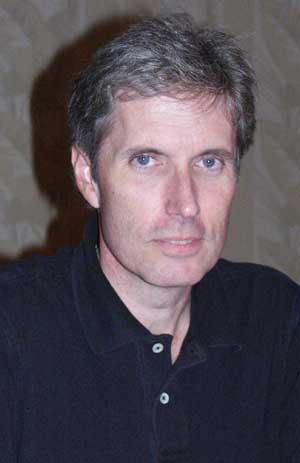
|
|
On Saturday - January 10th, 2004 - our guest was screenwriter and author Michael Cassutt, talking about his new space techno-thriller Tango Midnight.
Science Fiction has a long history of popular writers who are also 'working' scientists and engineers, such as Greg Benford, Charles Sheffield, Vernor Vinge, George O. Smith and many others. And it is their proximity to the frontiers of science that gives their fiction a special flavor.
But what are we to make of Michael Cassutt? He isn't a working scientist or engineer. And yet when he writes a novel about spaceflight he gets all the details right and captures the flavor of the 'space business' better than just about anybody I know.
|
I'm not going to try and analyze how he does what he does. I'm just going to tell you that he does it really well. The amount of thought and research that goes into his books is amazing. As is his obvious love of the subject. Whenever he releases a new novel about the space program I know I'm in for a good read. And that is as good a reason as any to have him back on Hour 25.
Tango Midnight is a techno-thriller set on the International Space Station that draws its background from events happening in the world around us; from terrorism to biomedical research, from NASA office politics to space policy, from space tourism to the difficulties of balancing your personal life with your career. I was unable to put this book down once I started reading it and was wanting more as soon as I finished it. Michael did a great job of crafting an exciting story that didn't play fast and loose with the technical realities of spaceflight.
Michael has my unending appreciation for his willingness to do the hard work of crafting a story within the constraints of 'how things really work' and for not taking the easy way out by playing fast and loose with the facts when the writing got difficult. Tango Midnight is a really good book. I enjoyed it greatly and recommend it most highly.
|

|
|

|
Dateline: Mars

Image Credit: NASA/JPL
|
|
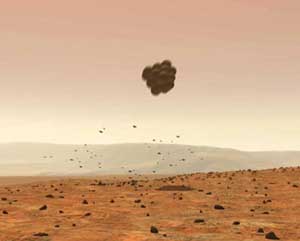
Image Credit: NASA/JPL
|
A week ago the first Mars Exploration Rover - Spirit - successfully landed on Mars. After spending six months traveling through space at speeds of thousands of miles per hour it plunged into the Martian atmosphere where aerodynamic forces quickly slowed it to a speed of a few hundred miles per hour. A parachute controlled its descent until it was close to the Martian surface and then braking rockets brought the vehicle to almost a complete stop not far from the surface.
The parachutes were then released and the rover fell to the ground, protected by multiple airbags. After bouncing a few times the Mars Exploration Rover came to rest on the Martian surface, enclosed within the spacecraft that had carried it from the Earth.
|
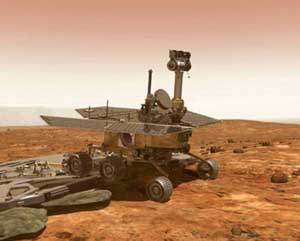
Image Credit: NASA/JPL
|
|

Image Credit: NASA/JPL
|
Not long after it stopped bouncing the Lander unfolded its triangular sides and exposed the Rover to the Martian environment. After a period of several days, after the Rover has been carefully checked out by engineers on the Earth, it will drive off the lander and start its studies of the Martian surface. If all goes well - and so far it has - this will happen in the next few days.
After leaving the Lander the Mars Exploration Rover will embark on a three month period of Martian exploration. Guided by engineers and scientists on the ground it will traverse the Martian surface and give us an unprecedented look at the surface of a world that has filled our dreams with wonder and a desire to go there.
With any luck, it will not be too many years before human footprints join the wheel prints of the the Spirit Rover on the surface of the Red Planet.
|
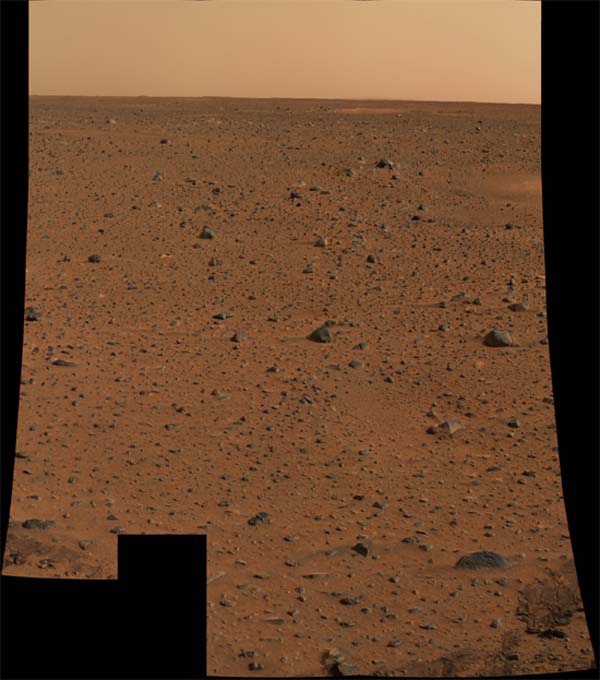
Image Credit: NASA/JPL
|
Presented above is a color image of the area where the Mars Exploration Rover landed. In a few days the Rover will be driving through that rock field, taking photographs, gathering information and following our dreams to the never ending horizon.
|

Image Credit: NASA/JPL
|
Show above is a 3D anaglyph of the Martian surface taken by the Mars Exploration Rover. You'll need red/Cyan glasses to see the 3D effect, but trust me - this is way more cool than any 3D movie from the 50's 'cause it's real.
To view many more Martian 3D images be sure to go to the Mars Unearthed web site. They even have some 3D images created from pictures taken by orbiting spacecraft that are wondrous in the extreme. Most highly recommended!
|
Dateline: Deep Space
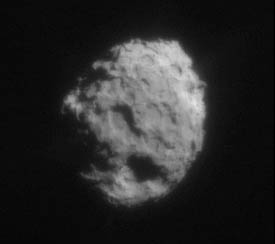
Image Credit: NASA/JPL
|
|

Image Credit: NASA/JPL
|
A little over a week ago the Stardust spacecraft successfully executed a fly-by of the Comet Wild 2 at a distance of approximately 150 miles. Whilst doing that it extended a sample collection arm and retrieved numerous small particles from the gaseous coma that surrounds the nucleus of the comet. Those samples are now tucked into an re-entry capsule within the Stardust spacecraft which is on a trajectory taking it back to Earth. When it arrives back here in a couple of years the re-entry vehicle will plunge into the Earth's atmosphere and land in the Utah desert. Studies of these samples will give us a window into the conditions that existed during the origin of the Solar System.
But in addition to getting samples of the Comet's coma, the Stardust spacecraft also returned a series of images of Wild 2. Two of those images are shown above. Studies of the structures found on this comet will give scientists great insights into the physical processes occurring on cometary surfaces.
|
Listen to this show
|

|
- Click here to listen to the entire show. {1:38:47}
Or
- Click here for the show's intro music.{0:41}
- Click here for the show's opening. {31:50}
- Click here for our interview with Michael Cassutt. {1:05:18}
- Click here for the show's closing.{1:58}
- You can also listen to the interview we did with Michael in 2001 where we discussed his book Red Moon.
- Click here for an index of all Shows on our site.
|
Click here if you have a problem hearing the show and you're using Internet Explorer.
If you enjoyed this show and would like to know when other interviews are uploaded to the Hour 25 web site, then send an email to me at wwjames@earthlink.net and I will add your name to the free Hour 25 Newsletter mailing list. That way you'll get a brief notice in your email every time a new show gets uploaded to the web.
Links for more information relating to this week's show
Space News - Mars
For more information about the Mars Exploration Rovers be sure to check out the MER Web Site at JPL or this Mars Rover site at Cornell University.
For more information about the Beagle 2 Mars Lander be sure to check out the Beagle 2 Official Web Site, the ESA Beagle 2 Web Page or this article about Beagle 2 from Astrobiology Magazine.
Images of the Beagle 2 landing site as seen from the Viking Orbiter and Mars Global Surveyor can be viewed here {Part 1} and here {Part 2}.
To learn more about the Mars Express mission you can go to this ESA Mars Express Web Site, this Mars Express Web Page from JPL, this NSSDC Mars Express Web Page, or this Web Page from Mars News.Com.
To learn more about the Nozomi Mars Mission you can view this Web Site from the Institute of Space and Astronautical Science or this Web Site from the National Space Science Data Center. For more information about the ending of the Nozomi Mars Mission you can read this report at Spaceflight Now.
For more information about the Exploration of Mars be sure to go to the JPL Mars Exploration Site, the Center for Mars Exploration at NASA Ames, or the Mars Missions Web Site at the Planetary Society.
Information about the data returned by previous Mars missions can be found at this Mars Web Page at the NSSDC.
Information about the Phoenix Mission to Mars can be found at this Press Release from the University of Arizona. You can view a 3D picture of the Mars Phoenix spacecraft here.
For more Mars news be sure to check out the Mars News.Com Web Site.
Percival Lowell did much to shape our ideas about Mars in the early years of the 20th Century. You can learn more about his work by reading this on-line copy of his 1895 book Mars.
For On-Going Updates on Space News
The Reusable Launch & Space Vehicle News Web Site Web Page that is part of the Hobby Space Web Site is a really good place to watch for news about, well... Reusable Launch Vehicles and related subjects. I check it out just about every day and often find news there that doesn't show up anywhere else. Give it a look. {And while you're there be sure to check out some of the site's other pages. Wow! Is there a lot of information there.}
The Space Today Web Site is a great place to find space news from all over the 'net.
The Spaceflight Now Web Site carries real time information about current space missions and presents a lot of space and astronomy news. This is the place I go to when I want up to the minute information about current space missions. Do I need to say more?
The NASA Watch Web Site is another great place for getting information about current space missions. Check there also for news about other 'goings on' within NASA. Highly recommended.
Space News - The Columbia Accident - On-Going
The Columbia Accident Report
You can read the Report of the Columbia Accident Investigation on-line or download it by going here. {You will also find a link there in case you want to order a hard copy.}
The Smoking Gun
Ongoing testing by NASA seems to have found the "smoking gun" in the Columbia accident. {At least as far as the technical problems go. For information about NASA's management problems, see the news item below.} Tests found that a foam impact on the leading edge of the Shuttle's wing would blow a 16 inch hole in that structure as well as cracking and damaging other parts of the Shuttle's wing. For more information check out these stories from the Orlando Sentinel, Florida Today, Reuters, Spaceflight Now and The Houston Chronicle.
The Management Problem
Be sure to read this story from the Orlando Sentinel which discusses previous Shuttle missions where foam from the ET damaged the Shuttle's TPS and NASA's approach to dealing with this problem in the future.
During the Apollo 13 accident the words of Flight Director Gene Krantz, "Failure is not an option", set the tone for what NASA would do and went a long way toward getting the crew safely back to Earth. But during the flight of the Columbia things were quite different. Linda Ham, the head of the Mission Management Team, was not interested in getting better data about the result of the foam impact or coming up with a crash program to rescue the Columbia astronauts because, as she said, "I don't think there is much we can do". Read more about this shocking revelation at this report from the Washington Post and at this story from the Florida Today Web Site .
Be sure to check out this story from the Florida Today Web Site which details a long history of unresolved safety issues affecting the Shuttle.
Concerning Future Developments
For an interesting assessment of the Orbital Space Plane project, be sure to read this report by Jeffrey F. Bell. You might or might not agree with him, but his calculations certainly give you something to think about.
More information about the Orbital Space Plane (OSP) can be found here, another view about the OSP can be found here and another opinion about this project can be found here.
On-Going Coverage and Reference Sources
The Columbia Accident Investigation Board Web Site is a good source for information about the results of the on-going investigation into the loss of the Columbia.
NASA has a Web Site with information about the loss of the Columbia, the on-going investigation into this accident, the crew and other related subjects.
CAD Digest has a very good compilation of information about the Columbia accident.
Florida Today has a Web Site with updated coverage of the loss of the Columbia.
This NASA Web Page contains pictures of the crew of the Columbia along with other pictures from their mission. {Audio files from STS-107 can be found here and video files can be found here.}
You can find the Press Kit from the STS-107 mission here.
ISS News
The Florida Today Web Site has a very interesting report about the causes of the ISS budget problems and their impact on the space program. It makes very interesting reading.
Click here to view the press kits for various ISS missions.
Check out the NASA International Space Station Web Page or the Boeing Web Page to learn more about this project.
A great source of news about Russian space activities, including their work on the ISS, can be found at the Russian Space Web.
Do you wonder where the Space Station is right now? You can use your browser to view real time maps showing the location of the ISS by going to this link at the NASA Space Link Web Site or here at the Johnson Spacecraft Center. Please note that your browser must support Java to make use of this satellite tracking software.
You can find out when the ISS - or many other spacecraft - can be seen from your location by going to this NASA Web Page. Please note; your browser must support Java for this application to work.
Click here for information about the audio files used for Hour 25 and for information about configuring your browser and downloading audio players.
Please note Web Pages from external sites will open in a separate browser window and that Hour 25 Productions are not responsible for the content of any external Web Sites.
|
Return to the Index for this month's shows
Back to Hour 25 Home Page
Unless otherwise noted the entire content of this web site is
Copyright © Warren W. James, 2000-2004. All rights reserved.
|
|






















